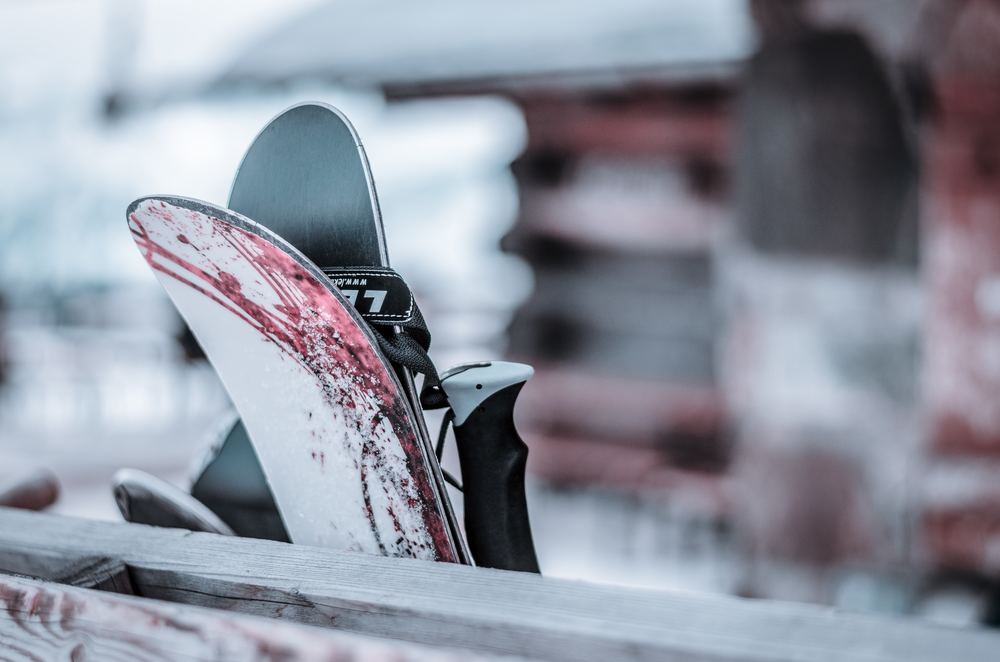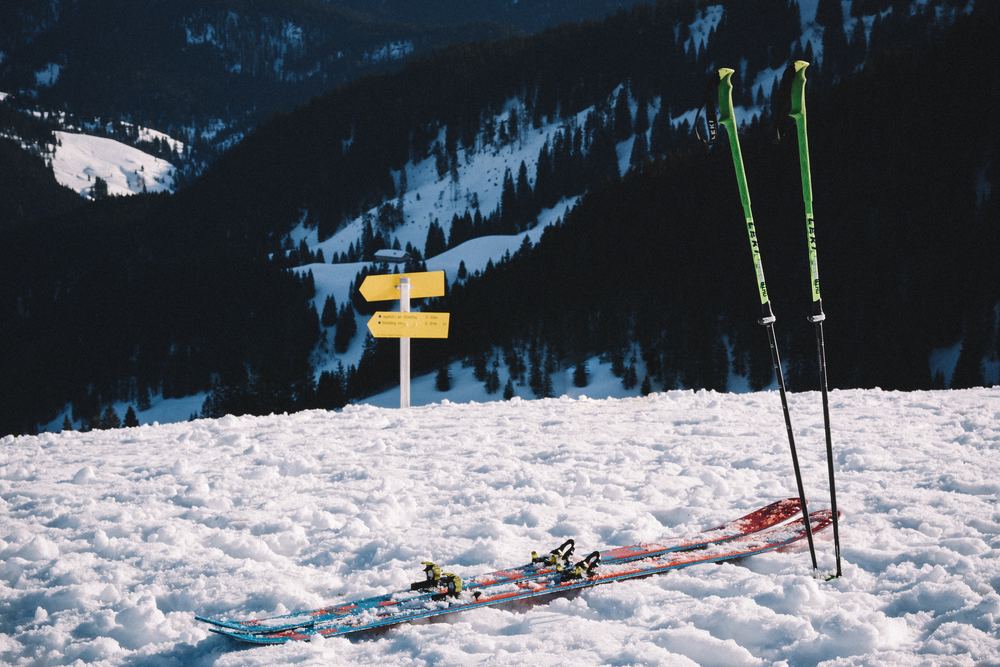The coming of summer might mean beaches, ice cream, and a generally fun time for other people, but for you, it means having to put away your skis or snowboards until next season.
What is the best way to store skis and how can you make sure they remain in top shape for winter? Read on to learn how to store your skis for the summer!
Contents
The Importance of Knowing How to Store Skis and Snowboards Properly
If you just dump your skis or snowboards in your garage right after the season ends, you risk exposing them to dampness, mold, dryness, and other seasonal changes that can have an adverse effect on the health of your skis.
Knowing how to store snow skis or boards properly can prevent rusting, prolong the life of your equipment, and even improve their overall performance!
How to Prepare Your Skis for Storage
First, you should lay out all your skiing or snowboarding equipment to see what needs to be repaired or replaced before the next winter season. This way, you can avoid the crowds clogging up the ski shops during this time, and instead ski or snowboard to your heart’s content.
Of course, if you don’t know how to tune your own skis and boards, or are just uncomfortable doing it yourself, you can always have your local ski shop do it for you. It’s best to get this done in the summer when there are fewer people around.
What Supplies You Need
- Cloth.
- Gummy stone.
- Rubber bands.
- Base cleaner.
- Plastic scraper.
- Bronze or steel ski brush.
- All-temperature wax (or P-Tex).
- Waxing iron.
- Basic waxing station.
It’s important to tune and wax your skis and snowboards every year.
Prep Your Bases
Pull your brakes back with a large rubber band, so that they’re out of the way. Then, clean your skis or your board with a damp cloth dipped in base cleaner.

Use the Gummy Stone
If your skis or board have any rust on them, use your gummy stone to scrape it off. These helpful tools are available in two different styles: soft and hard.
Soft gummy stones are often used to remove minor surface rust, while hard gummy stones are more abrasive and used to remove burrs. Don’t mix them up, or you might harm your equipment.
There are also tools called diamond stones, which are stones that serve the same function as files but are purposefully designed to give your skis or snowboard a more accurate edge angle. Their coarseness ranges anywhere between 100 and 1,000, with 100 being considered extra-coarse.
The higher the degree of grit, the sharper your ski or snowboard edges will be.
You should never use a diamond stone to take the rust off your equipment. In fact, unless you are an advanced-level skier or snowboarder who often tunes their own equipment, you should avoid the diamond stone altogether, as you risk damaging your skis or board if used improperly.
When scraping the rust off your skis or snowboard, make sure you hold your gummy stone horizontally and pass it across the edges at a 90-degree angle, moving it from tip to tail. Do this for both bases before moving on to the next step.
Fix Any Major Scrapes or Gouges
Inspect your skis or board for any small nicks or burrs on their surfaces. If they have any large scrapes, you should take them to a ski shop to have them repaired, rather than trying to fix them yourself.
For minor ones, light the end of your P-Tex stick and put that end to the scrape. Make sure you don’t hold the stick up too high over your skis or board, as this could accidentally burn your base.
Let the P-Tex melt into the gouge and fill it up. Once this is done, remove the P-Tex stick and blow it out.
Let your base cool for about 10 minutes before scraping off any excess dried P-Tex with your scraper. Repeat until it’s smooth to the touch.
Be sure you hold your scraper horizontally (like the gummy stone) and push it along from tip to tail. Repeat this process for both bases when you see any small nicks in them.
Should You Clean Skis and Snowboards Before Storing Them?
Absolutely. You should wipe them off with a clean, damp cloth before you even think of tuning and waxing them, or even hose them down if they are really dirty. After all, skis and snowboards can pick up a lot of dirt and debris over the season.

Be sure to spray everything quite thoroughly, but do not force any water into your bindings. Don’t use any degreasers or detergent to clean them, either.
These could affect the binding lubricant and destroy your skis or board. If your equipment has a stubborn build-up of gunk on them, then dip your cloth in a citrus solvent to take that off.
Start by wiping the top sheets, then work your way to the bases, edges, and around the bindings. It’s important to let your skis or your board dry out properly before trying to tune them. In fact, it’s best to let them dry out overnight before you get to work on the rest.
Use Your Brush
Once you’re sure your board and/or your skis are dry, gently brush the grain of the bases with a normal bronze or steel ski brush – again, from tip to tail.
You should always go in one direction, and never clean your skis or board in a side to side motion. Brushing your skis or board after the initial cleaning will remove any dirt that may have been left over.
Once this is done, wipe them off again with your clean cloth.
Sharpen the Edges (Optional)
It’s also wise to sharpen the edges of your skis or snowboard during this time.
While enlisting a professional will deliver the best results, you can do it yourself. Just be patient and ensure you have the right tools.
Waxing Your Skis or Snowboard
Waxing your skis or snowboard can protect your bases from rust and other sorts of damage caused by the elements.
Turn your waxing iron on to low heat. This ensures that your wax won’t smoke on the heat plate once you press it onto the iron.
Make sure you hold the iron and the wax about three or so inches above your skis or board. Let a few drops of wax fall every two or three inches apart over 1/3 of your skis’ or snowboard’s base.
To spread the wax, simply push your iron along 1/3 of its surface, making sure it stays in constant motion, so as to avoid burning your skis or snowboard.
Repeat this for the other 2/3 of the base, then let your skis or snowboard cool for five minutes. Don’t be afraid to apply a generous amount all over the bases!

When it does harden, do not scrape the wax off! Instead, leave it on for the summer to act as a natural preservative, which will prevent the bases from drying out.
Once the winter season finally comes around again, remember to scrape your skis or snowboards again before you decide to hit the slopes!
Where to Store Skis and Snowboards
Dumping all your equipment in a single ski bag over the summer could actually do more harm than good. This is because these bags may contain leftover moisture that could rust your skis’ edges throughout the warm months.
Keep your skis or snowboards in a safe, dry place indoors where they won’t be exposed to the elements.
You don’t need a special climate-controlled closet to keep them. In fact, as long as your garage isn’t prone to getting leaks or doesn’t have any spaces that heat up more than normal, storing them out there should be fine.
This video gives more information on storing skis for the summer.
Best Conditions for Storage
Strapped Tight
Keep your skis strapped together using a Voile strap or something similar; this will help prevent the edges from rubbing against each other and growing dull.
A strong strap also prevents your skis from scissoring and falling to the ground.
Don’t Compress the Camber or Rocker
When you do wrap them up, be sure to not strap them together in a way that compresses the camber or rocker. This can warp your skis into a weird shape and make them nearly unusable.
Carefully wrap the strap around the area where the skis naturally meet (that is, the tip and the tail). DO NOT yank on the strap.
Of course, if you don’t want to hang them up, you can also store them on their side underneath your bed.
In the House with You
Always keep your skis or snowboard in a cool, dry place out of direct sunlight. That means you shouldn’t store them in your attic or garage if you know they can get hot or damp in the summer and fall respectively.
The ideal storage place would be inside your house, perhaps under your bed or in a large closet.
Organized and Together
Be sure to keep your ski gear and apparel all in one spot during the summer months.
Not only will this help you gather your things easily once the winter season hits, but it will also keep you better-organized clothes-wise, too.
Storing Bindings
Experts tend to have different opinions on storing bindings in the off-season. Some believe that you need to release the tension in your bindings by putting them on the lowest setting, while others say that leaving the bindings alone is fine.

The former group’s thinking is sound, as this would extend the life of your skis or snowboard’s bindings. However, you will have to reset the bindings to the correct settings again before you head off to the slopes.
Ultimately, it depends on if you’d rather take the time to readjust your equipment before each season.
Loosening the Bindings
If you choose to lessen your bindings’ tension, loosen them to the lower end of their available DIN scale.
Never completely loosen the bindings or you might have trouble putting them back on again; in which case, you would need to see your local ski shop about repairs.
Adjusting Heel Pieces
You can move your alpine binding heel pieces to the “ski” position to relieve the tension, too.
Simply put the heel cylinders up on Rossignol, Look, or Marker bindings or the latch up and heel interface down for Salomon bindings.
You may also choose to switch the tech toe pieces to the “closed” position (or toe levers up) instead.
Removing Bindings or Their Screws
Some people choose to remove their bindings completely or at least loosen their bindings’ screws in the summer. This reduces stress on the inserts and prevents base dimples.
If you want to do this, it’s wise to write the exact DIN numbers on a piece of tape and stick it on your skis as a reminder for next time.
How to Store Ski Boots
You should first check your boots for any noticeable cracks, broken buckles, or torn straps; there’s no point in cleaning messed-up boots.
Again, a thorough inventory check before you even start cleaning will be very helpful to you in the future.
If your boots are fine, then wipe them down with a clean cloth and let them completely air out before storing them. You should remove the soft inner liner of the boots and lay that out to dry separately before putting it back in.
Your boots should be stored in a cool, dry place and not be compressed whatsoever in storage. Boot liners are typically molded by heat and can thus lose their shape if they are stored somewhere too hot.
This includes places that deal with extreme temperature changes, like a backyard shed or your attic.
This video goes into more detail on how to store ski boots.
Conclusion
Knowing how to store your skis and snowboards after the season ends is crucial to the overall health of your equipment.
If you want to keep them in the best shape for as long as possible, the methods above will serve you well!
Tell us your best way to store skis!





